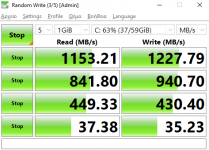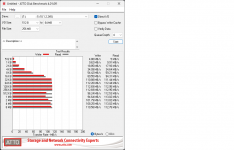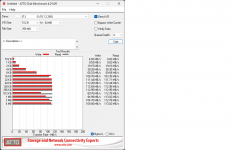Hello to everyone,
I have been using TrueNAS for some time and I would like your help with the following findings.
Supermicro X10SL7-F
Xeon E3-1245 v3
32GB RAM ECC
LSI 2308 (on board), IT mode (passthrough to TrueNAS)
4x2TB, ZFS mirror, VMFS6 datastore
Intel 82599 10Gb
Everything updated to the latest firmware.
I haven't been running extensive performance tests. Just using ATTO Benchmark and Crystal Mark.
Bare metal installation:


ESXi 7.0 U2, VM installation (LSI 2308 and Intel 82599 passthrough), no other VM:


I am getting significantly lower performance in the VM installation comparing to the bare metal.
I have tried TrueNAS Auto-tune, changing PCIe slot to network card, several BIOS settings and VM settings. No success.
To a certain extent, I realize that I might not get the same performance but the gap seems to big to me.
Any thoughts or suggestions would be greatly appreciated.
Thank you in advance.
I have been using TrueNAS for some time and I would like your help with the following findings.
Supermicro X10SL7-F
Xeon E3-1245 v3
32GB RAM ECC
LSI 2308 (on board), IT mode (passthrough to TrueNAS)
4x2TB, ZFS mirror, VMFS6 datastore
Intel 82599 10Gb
Everything updated to the latest firmware.
I haven't been running extensive performance tests. Just using ATTO Benchmark and Crystal Mark.
Bare metal installation:
ESXi 7.0 U2, VM installation (LSI 2308 and Intel 82599 passthrough), no other VM:
I am getting significantly lower performance in the VM installation comparing to the bare metal.
I have tried TrueNAS Auto-tune, changing PCIe slot to network card, several BIOS settings and VM settings. No success.
To a certain extent, I realize that I might not get the same performance but the gap seems to big to me.
Any thoughts or suggestions would be greatly appreciated.
Thank you in advance.



